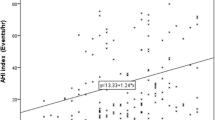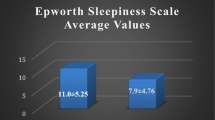Abstract
Purpose
To assess prevalence of self-reported nasal congestion and its association with sleep-disordered breathing (SDB) and excessive daytime sleepiness (EDS) in Pakistani adults employed at a medical university.
Methods
All full-time employees of a medical university (n = 3,470) were delivered a questionnaire that elicited demographic data, symptoms of nasal blockage and SDB and Epworth Sleepiness Scale score. Overnight pulse oximetry was performed on self-reported snorers and a random sample of non-snorers. Supervised polysomnography was performed on subjects with oxygen desaturation index > 5/h. Logistic regression analysis was used to assess the association of nasal blockage with SDB and EDS.
Results
Of 2,497 (72%) responders, 45.2% reported nasal congestion. Self-reported nasal blockage was significantly associated with an increased risk of SDB symptoms: snoring (odds ratio [OR] 1.9), witnessed apnoea (OR, 2.2) and unrefreshing sleep (OR, 1.7). Those with nasal blockage had higher Epworth Sleepiness Scale score (5.5 ± 3.6 vs. 3.9 ± 3.3, p < 0.001) compared with those without nasal blockage. Nasal blockage was associated with increased risk of doziness in seven out of eight items of Epworth Sleepiness Scale score. Oxygen desaturation index and apnoea–hypopnoea index were similar between subjects with and without self-reported nasal blockage.
Conclusion
Self-reported nasal blockage is a common symptom in employed Pakistani adults. Self-reported nasal blockage is significantly associated with symptoms of SDB and EDS but not with respiratory variables on overnight sleep monitoring.


Similar content being viewed by others
References
Björkstén B, Clayton T, Ellwood P, Stewart A, Strachan D, ISAAC Phase III Study Group (2008) Worldwide time trends for symptoms of rhinitis and conjunctivitis: phase III of the International Study of Asthma and Allergies in Childhood. Pediatr Allergy Immunol 19:110–124
Bauchau V, Durham SR (2004) Prevalence and rate of diagnosis of allergic rhinitis in Europe. Eur Respir J 24:758–764
Armengot M, Hernández R, Miguel P, Navarro R, Basterra J (2008) Effect of total nasal obstruction on nocturnal oxygen saturation. Am J Rhinol 22:325–328
Stradling JR, Crosby JH (1991) Predictors and prevalence of obstructive sleep apnea in 1,001 middle-aged men. Thorax 46:85–90
Stull DE, Roberts L, Frank L, Heithoff K (2007) Relationship of nasal congestion with sleep, mood, and productivity. Curr Med Res Opin 23:811–819
Young T, Finn L, Kim HC (1997) Nasal obstruction as a risk factor for sleep-disordered breathing. J Allergy Clin Immunol 99:S757–S762
Young T, Finn L, Palta M (2001) Chronic nasal congestion at night is a risk factor for snoring in a population-based cohort study. Arch Intern Med 161:1514–1519
Udaka T, Suzuki H, Fujimura T, Hiraki N, Ohkubo J, Shiomori T, Ueda N, Hashida K, Mori T, Fujino Y (2007) Chronic nasal obstruction causes daytime sleepiness and decreased quality of life even in the absence of snoring. Am J Rhinol 21:564–569
Ng TP, Tan WC (2005) Prevalence and determinants of excessive daytime sleepiness in an Asian multi-ethnic population. Sleep Med 6:523–529
Khassawneh B, Ghazzawi M, Khader Y, Alomari M, Amarin Z, Shahrour B, Hammouda M (2009) Symptoms and risk of obstructive sleep apnea in primary care patients in Jordan. Sleep Breath 13:227–232
Li KK, Kushida C, Powell NB, Riley RW, Guilleminault C (2000) Obstructive sleep apnea syndrome: a comparison between Far-East Asian and white men. Laryngoscope 110:1689–1693
Lam B, Ip MS, Tench E, Ryan CF (2005) Craniofacial profile in Asian and white subjects with obstructive sleep apnoea. Thorax 60:504–510
Johns MW (1991) A new method for measuring daytime sleepiness. The Epworth Sleepiness Scale. Sleep 14:540–545
Olson LG, Cole MF, Ambrogetti A (1998) Correlations among Epworth Sleepiness Scale scores, multiple sleep latency tests and psychological symptoms. J Sleep Res 7:248–253
Rechtschaffen A, Kales A (eds) (1968) A manual of standardized terminology, techniques and scoring system for sleep stages of human subjects. Washington, D.C.: Government Printing Office. (NIH publication no. 204)
Ray N, Baraniuk J, Thamer M, Rinehart CS, Gergen PJ, Kaliner M, Josephs S, Pung YH (1999) Direct expenditures for the treatment of allergic rhinoconjunctivitis in 1996, including the contributions of related airway illness. J Allergy Clin Immunol 103:401–417
Radon K, Gerhardinger U, Schulze A, Zock JP, Norback D, Toren K, Jarvis D, Held L, Heinrich J, Leynaert B, Nowak D, Kogevinas M, Occupational Group of the ECRHS study (2008) Occupation and adult onset of rhinitis in the general population. Occup Environ Med 65:38–43
Li S, Jin X, Yan C, Wu S, Jiang F, Shen X (2008) Bed- and room-sharing in Chinese school-aged children: prevalence and association with sleep behaviors. Sleep Med 9:555–563
Léger D, Annesi-Maesano I, Carat F, Rugina M, Chanal I, Pribil C, El Hasnaoui A, Bousquet J (2006) Allergic rhinitis and its consequences on quality of sleep: an unexplored area. Arch Intern Med 166:1744–1748
Storms WW (2004) Pharmacologic approaches to daytime and nighttime symptoms of allergic rhinitis. J Allergy Clin Immunol 114:S146–S153
Smolensky MH, Lemmer B, Reinberg AE (2007) Chronobiology and chronotherapy of allergic rhinitis and bronchial asthma. Adv Drug Deliv Rev 59:852–882
Krouse HJ, Davis JE, Krouse JH (2002) Immune mediators in allergic rhinitis and sleep. Otolaryngol Head Neck Surg 126:607–613
Storms W (2008) Allergic rhinitis-induced nasal congestion: its impact on sleep quality. Prim Care Respir J 17:7–18
Rappai M, Collop N, Kemp S, deShazo R (2003) The nose and sleep-disordered breathing: what we know and what we do not know. Chest 124:2309–2323
Stoohs RA, Knaack L, Blum HC, Janicki J, Hohenhorst W (2008) Differences in clinical features of upper airway resistance syndrome, primary snoring, and obstructive sleep apnea/hypopnea syndrome. Sleep Med 9:121–128
Gottlieb DJ, Yao Q, Redline S, Ali T, Mahowald MW (2000) Does snoring predict sleepiness independently of apnea and hypopnea frequency? Am J Respir Crit Care Med 162:1512–1517
Hutter DA, Holland BK, Ashtyani H (2004) Occult sleep apnea: the dilemma of negative polysomnography in symptomatic patients. Sleep Med 5:501–506
Tosun F, Kemikli K, Yetkin S, Ozgen F, Durmaz A, Gerek M (2009) Impact of endoscopic sinus surgery on sleep quality in patients with chronic nasal obstruction due to nasal polyposis. J Craniofac Surg 20:446–449
Nakano H, Ikeda T, Hayashi M, Ohshima E, Itoh M, Nishikata N, Shinohara T (2004) Effect of body mass index on overnight oximetry for the diagnosis of sleep apnea. Respir Med 98:421–427
Hussain SF, Fleetham JA (2003) Overnight home oximetry: can it identify patients with obstructive sleep apnea–hypopnea who have minimal daytime sleepiness? Respir Med 97:537–540
Chiner E, Signes-Costa J, Arriero JM, Marco J, Fuentes I, Sergado A (1999) Nocturnal oximetry for the diagnosis of the sleep apnoea hypopnoea syndrome: a method to reduce the number of polysomnographies? Thorax 54:968–971
Acknowledgements
We are grateful to employees of the Aga Khan University, Karachi, who participated in the study and to research officers for collecting the data. We are indebted to several colleagues for their guidance, assistance and encouragement particularly during the initial stages of study. Finally, we wish to thank the University Research Council for approving the grant to support the study.
Competing interests
None.
Funding
The University Research Council at Aga Khan University supported this research under a research grant award for US $35,000.
Author information
Authors and Affiliations
Corresponding author
Rights and permissions
About this article
Cite this article
Hussain, S.F., Cloonan, Y.K., Rahbar, M.H. et al. Association of self-reported nasal blockage with sleep-disordered breathing and excessive daytime sleepiness in Pakistani employed adults. Sleep Breath 14, 345–351 (2010). https://doi.org/10.1007/s11325-009-0317-8
Received:
Accepted:
Published:
Issue Date:
DOI: https://doi.org/10.1007/s11325-009-0317-8




